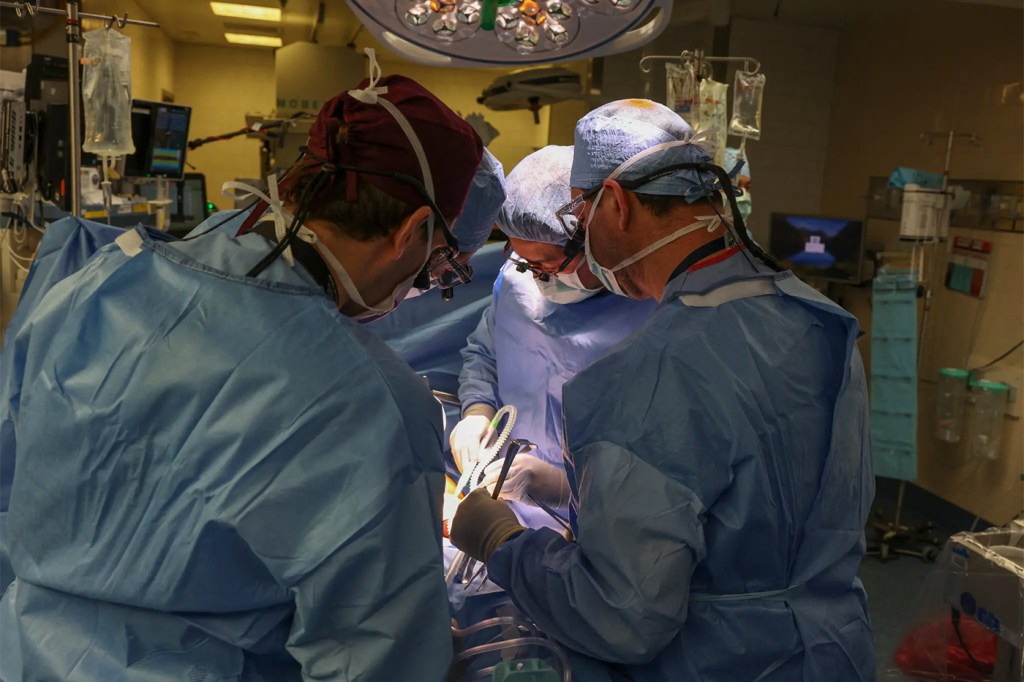What are the risks involved with donating a kidney? A transplant expert explains why pig organs may be the only option for some
Northeastern Global News spoke with Dami Ko, an assistant professor of nursing at Northeastern and a transplant expert, to learn more about kidney transplantation and what could be done to address the donation shortage.

The first man to receive a pig kidney died over the weekend, nearly two months after undergoing the transplant.
Doctors at Massachusetts General Hospital, where 62-year-old Richard Slayman underwent the procedure, said there is “no indication” that his death was the result of the pig kidney failing. The man had previously received a transplanted kidney from a human, but it had to be taken out due to complications.
The surgery, known as a xenotransplantation, was seen as a medical breakthrough in helping address the major global organ donation shortage.
And the shortage is pretty significant, according to the data.
Every day, 17 people in the United States die waiting for an organ transplant, according to the U.S. Health Resources and Services Administration. Kidneys in particular are in high demand. An estimated 786,000 patients were living with kidney failure in 2021, but less than 25,000 received a transplant, the National Kidney Foundation reported.
Transplantation numbers have gone up since then, but organ donor proponents continue to argue that if more people donated one of their kidneys, operations requiring organs from genetically modified pigs would be less necessary.
But what kind of risks are involved in donating a kidney?
Northeastern Global News spoke with Dami Ko, an assistant professor of nursing at Northeastern and a transplant expert, to learn more about kidney transplantation and what could be done to address the donation shortage.

This interview has been edited and condensed for clarity.
What factors must be considered in a kidney transplant?
First of all, there are two types of donations. One is you donate a kidney as a living donor, meaning that you give one of your kidneys to another person in need. In a deceased donation, you get a kidney from someone who has had brain death. So before we confirm someone’s death, when they are on life support, we start talking about organ donation and get consent [from family members].
When we decide on a donation, there are so many factors that need to be matched between recipients and donors. There are so many things that need to match like blood types, and also their DNA-like HLA, which is called human leukocyte antigens. Those are the key things that need to be matched.
There are some risk scores in the registry, but those who are in relatively good condition but really in need of those organs will get first place to those donated organs if they are a match.
What are the risks for a living person to donate one of their kidneys?
A lot of people would say the risk would be very low because it’s simply taking out their organ and giving it to someone else, but it’s a major surgery. It’s not a simple surgery.
You will need some time for recovery afterwards. During the process, you may also experience some kind of physical and psychological complications. It could be depression or pain. Some people may say, ‘Hey, I donated my organ but all the attention is being given to the recipient and not to me, and there is no one who is really supporting myself.’
Most people will recover pretty well, but some may have some long-term complications, and that may affect your ability to go back to work or go back to a normal life.
All those things may interfere with the living donor’s decision about whether they would want to give their organ to someone else.
Featured Posts
Do kidney donations often come from family members? Do cultural and religious beliefs become considerations?
If it’s within the family, the kidney disease might be genetic. For example, if your parent has the end stages of kidney disease, the child who is thinking about giving the kidney to the parent may also have a higher risk of getting that disease.
If they give one of their kidneys to their parent, that donor will be living with just one kidney themeslves. What if something happens to their kidney? They will need to get a kidney transplantation in the future.
Also, based on my perspective, another thing that really needs to be considered is cultural and religious beliefs.
I’m from South Korea, and at the time I was practicing there, probably 80% of donations were from living donors. It’s because of filial piety like the need to respect your parents and you should be willing to give your organs to your parents when they are in need.
And also, they think that donating your organs after life is not really good. You don’t want to harm your body. You want to keep an intact body for your afterlife or next life.
If the demand for kidney donations is not met, can xenotransplantation fill the gap?
It’s really hard to make someone donate their organs. It’s a really hard decision and many people don’t know much about organ donation. I think xenotransplantation can help reduce the mismatch between the demand and the shortage.
But not everyone can have the privilege of having a xenotransplantation, so I think increasing organ donation is really important, but we don’t know much about what would be the best strategy to increase the donor shortage.
Also, if we were to increase organ donations, some people still might not be able to find a good match to get a transplant. They may need to go with xenotransplantation when it becomes more popular and a more common practice in the future.
What kind of strategies can bridge the gap between those who need organ transplants and potential donors?
A lot of researchers have tried to bridge the gaps, but I don’t think they are up to date with the most effective strategies yet.
A lot of interventions have been conducted on the population level. You might have seen campaigns asking ‘Have you considered a donation?’ from the United Network for Organ Sharing, it’s a national department. Also, on the community level, if you go to the RMV or DMV, they ask questions about whether you’d like to be a donor.
At the education level, some people provide education programs at schools, like universities and high schools.
Hospital wise, they try to implement interventions and think about ways they can identify potential donors via brain death and actually use their organ to be transplanted from someone.
Although there are many different strategy levels, there is not one single effective way to improve donation sizes or attitudes. Research is still ongoing and I can’t give an answer on what would be the best way to do it, but I think a multilevel approach is a good way to do it because it will be effective to many people in the community from multiple levels.
The cultural perspective should also be considered. Every culture has different ideas about donations, especially those who are immigrants or those who are from a low socioeconomic status. They may not really trust the health care system, so they may not be willing to become a donor or willing to sign for their deceased family member.
All these things need to be considered, but I can tell a lot of researchers are working on it, and I really hope to see some progress in the future.










